
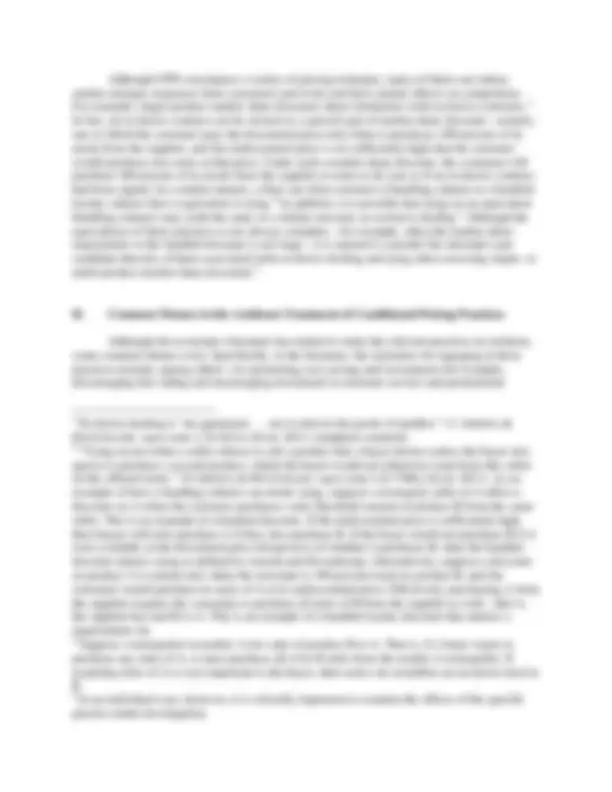
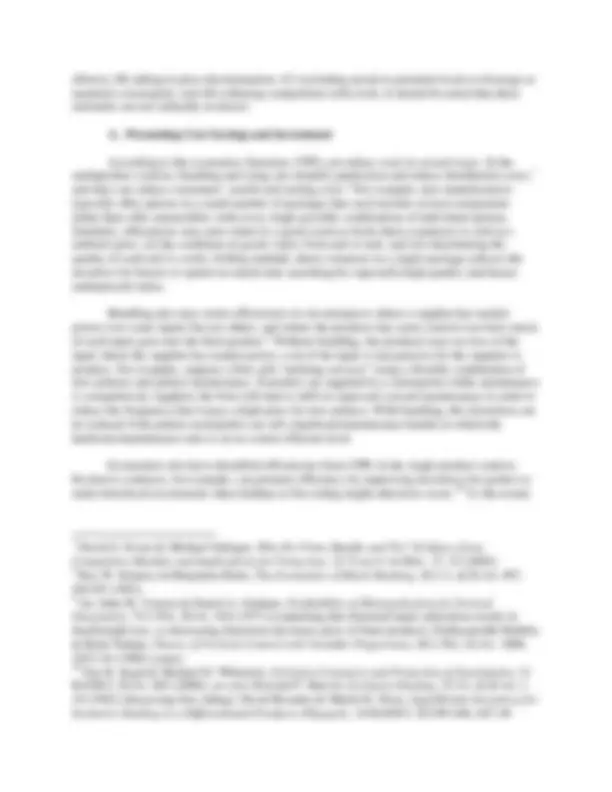
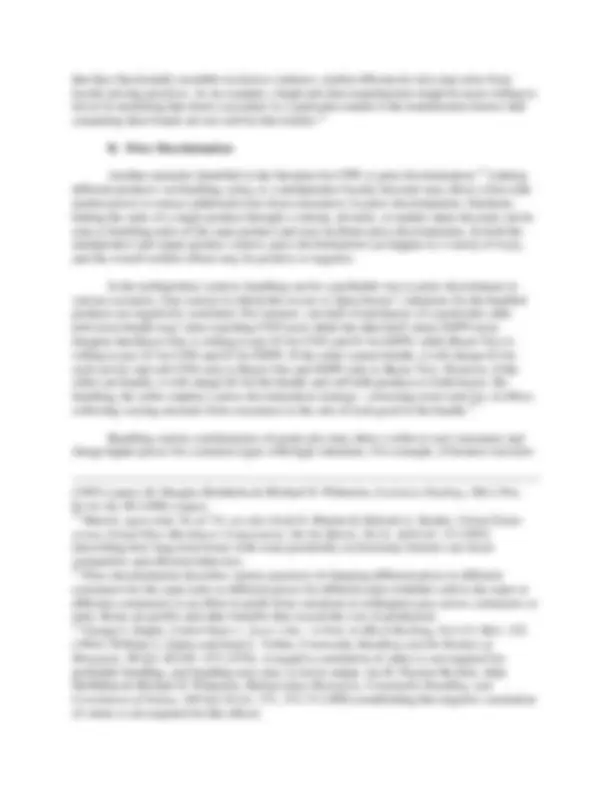
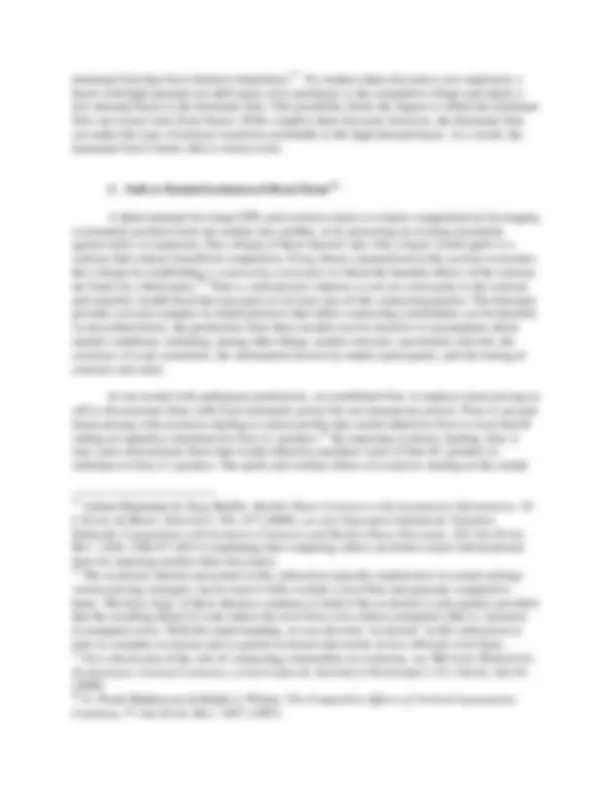
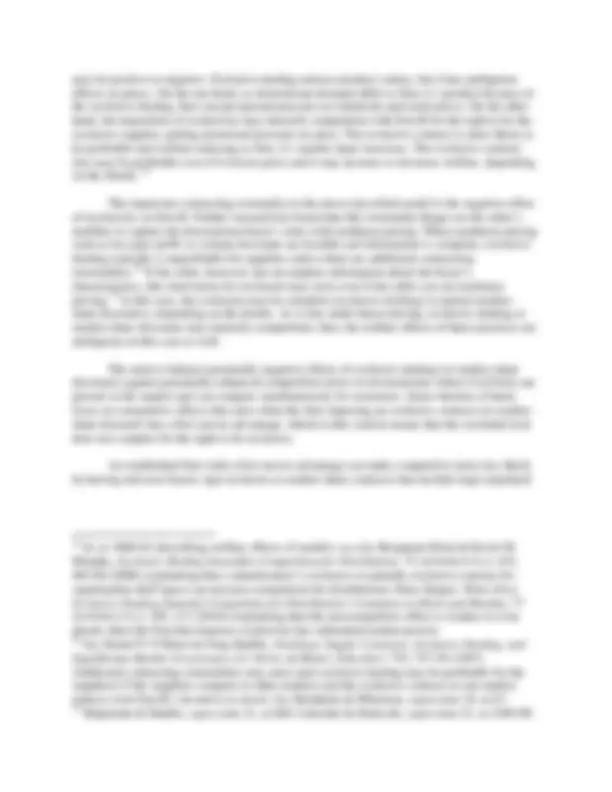
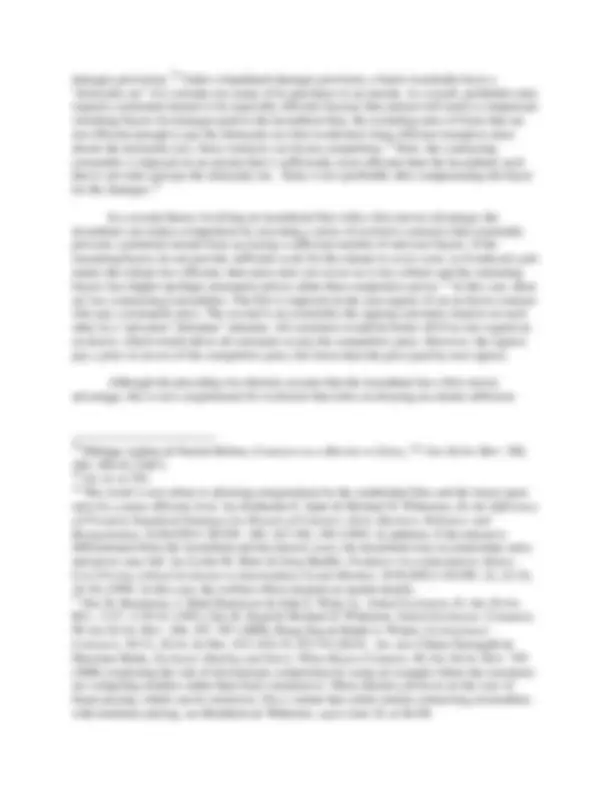
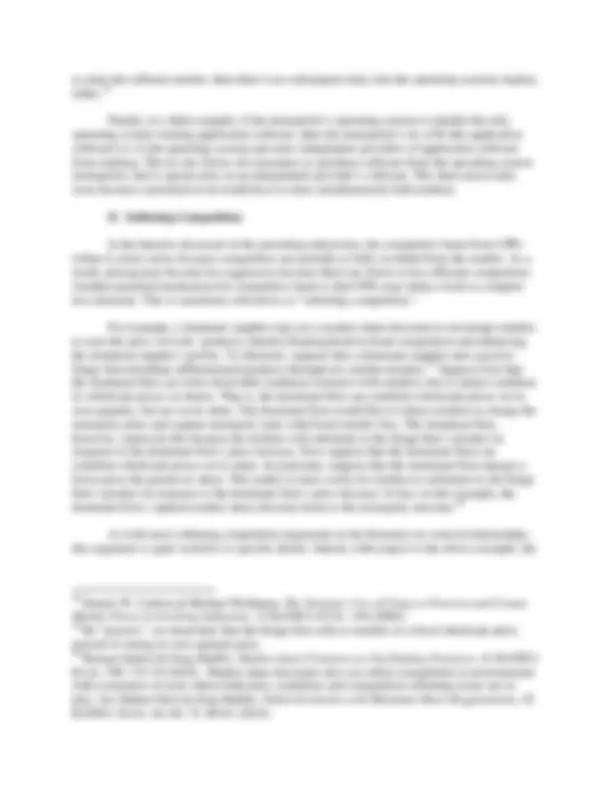



Study with the several resources on Docsity

Earn points by helping other students or get them with a premium plan


Prepare for your exams
Study with the several resources on Docsity

Earn points to download
Earn points by helping other students or get them with a premium plan
Community
Ask the community for help and clear up your study doubts
Discover the best universities in your country according to Docsity users
Free resources
Download our free guides on studying techniques, anxiety management strategies, and thesis advice from Docsity tutors
Conditional pricing practices (CPPs), focusing on loyalty discounts and exclusive deals. CPPs include strategies employed by firms to incentivize customer loyalty and extract additional rents through price discrimination. Loyalty pricing is based on a buyer's market share, while exclusive deals tie sales of one product to another. The document also discusses the potential effects of CPPs on competition and consumer welfare.
What you will learn
Typology: Lecture notes
1 / 14

This page cannot be seen from the preview
Don't miss anything!









Conditional Pricing Practices – A Short Primer
Patrick DeGraba Patrick Greenlee Daniel P. O’Brien*
September 2017
Abstract
Conditional pricing practices are pricing strategies in which a seller conditions its prices on factors such as volume, the set of products purchased, or the buyer’s share of purchases from the seller. This short primer provides a unifying overview of the economic literature that addresses these practices.
is an economist at the US Department of Justice (DOJ). Dan O’Brien is an economist and Partner at Bates White Economic Consulting. This paper was first drafted while O’Brien was a Senior Economic Policy Adviser at the FTC. These authors participated in a Public Workshop on Conditional Pricing Practices cosponsored by the DOJ and FTC on June 23, 2014. This paper can be considered a background document—it does not summarize or evaluate the economic and legal policy issues discussed at the Workshop. We thank Stephanie Beckett, Geoffrey Greene, Matthew Mandelberg, Jim Mongoven, and Andrea Zach for helpful comments. The views expressed herein are our own and do not necessarily represent the views of the DOJ, FTC, or Bates White Economic Consulting.
I. Definitions and Economic Context
Conditional pricing practices (CPPs) include a broad range of pricing strategies employed by many firms in the economy, including firms with large market shares and those with small shares. This broad range of practices^1 includes, among others: all-units and other quantity-based discounts, bundling, and market-share discounts.^2 Figure 1 provides a concise taxonomy of these practices based on whether they involve single or multiple products and whether the seller conditions price only on the buyer’s purchases of its product or also on the buyer’s purchases of rivals’ products.
Figure 1: Taxonomy of conditional pricing practices
(^1) The distinguishing feature of what we define as CPPs is that price is conditioned on quantities
or shares. We exclude resale price maintenance and exclusive territories from this set, although the effects of these practices are sometimes similar to the effects of CPPs. (^2) An all-units discount is a discount that applies to all units purchased on the condition of
reaching a purchase threshold. A quantity discount is any discount that arises from purchasing additional units. An all-units discount is a special case of a quantity or volume discount. Bundling occurs when a seller “charges less for an A/B package than the sum of the prices at which it sells A and B separately.” 10 P HILLIP AREEDA & HERBERT HOVENKAMP , ANTITRUST LAW: AN ANALYSIS OF A NTITRUST P RINCIPLES & THEIR APPLICATION ¶ 1758a (3d ed. 2011). Loyalty pricing (also known as a loyalty or market share discount) is a CPP based on “the share of the buyers’ purchases that come from a particular seller— e.g. , a 5 percent discount if one takes 70 percent of its needs from the seller, a 10 percent discount if one takes 80 percent of needs from the seller, and so on.” 3A AREEDA & HOVENKAMP , supra , ¶ 749a n.21 (4th ed. 2015); see also id. 11 AREEDA & HOVENKAMP , supra , ¶ 1807b2 (3d ed. 2011) (treating “loyalty discounts” as synonymous with market share discounts). Quantity discounts, also known as “volume discounts,” are practices in which pricing is linked to purchasing a specified quantity: “ e.g. , a 5 percent discount if someone takes 100 units or more, a 10 percent discount if someone takes 1,000 units or more, and so on.” 3A AREEDA & HOVENKAMP , supra , ¶ 749a n.21 (4th ed. 2015).
efforts); (B) aiding in price discrimination; (C) excluding actual or potential rivals to leverage or maintain a monopoly; and (D) softening competition with rivals. It should be noted that these rationales are not mutually exclusive.
A. Promoting Cost Savings and Investment
According to the economics literature, CPPs can reduce costs in several ways. In the multiproduct context, bundling and tying can simplify production and reduce distribution costs,^7 and they can reduce consumers’ search and sorting costs.^8 For example, auto manufacturers typically offer options in a small number of packages that each include several components rather than offer automobiles with every single possible combination of individual options. Similarly, efficiencies may arise when (i) a good (such as fresh cherry tomatoes) is sold at a uniform price, (ii) the condition of goods varies from unit to unit, and (iii) determining the quality of each unit is costly. Selling multiple cherry tomatoes in a single package reduces the incentive for buyers to spend too much time searching for especially high-quality (and hence underpriced) items.
Bundling also may create efficiencies in circumstances where a supplier has market power over some inputs but not others, and where the producer has some control over how much of each input goes into the final product.^9 Without bundling, the producer may use less of the input where the supplier has market power, even if the input is inexpensive for the supplier to produce. For example, suppose a firm sells “printing services” using a flexible combination of new printers and printer maintenance. If printers are supplied by a monopolist while maintenance is competitively supplied, the firm will tend to shift its input mix toward maintenance in order to reduce the frequency that it pays a high price for new printers. With bundling, this distortion can be reduced if the printer monopolist can sell a hardware/maintenance bundle in which the hardware/maintenance ratio is set at a more efficient level.
Economists also have identified efficiencies from CPPs in the single product context. Exclusive contracts, for example, can promote efficiency by improving incentives for parties to make beneficial investments when holdup or free-riding might otherwise occur.^10 To the extent
(^7) David S. Evans & Michael Salinger, Why Do Firms Bundle and Tie? Evidence from
Competitive Markets and Implications for Tying Law , 22 YALE J. ON R EG. 37, 52 (2005). (^8) Roy W. Kenney & Benjamin Klein, The Economics of Block Booking , 26 J. L. & ECON. 497,
502-05 (1983). (^9) See John M. Vernon & Daniel A. Graham, Profitability of Monopolization by Vertical
Integration , 79 J. P OL. E CON. 924 (1971) (explaining that distorted input utilization results in deadweight loss, so decreasing distortion decreases price of final product); Parthasaradhi Mallela & Babu Nahata, Theory of Vertical Control with Variable Proportions , 88 J. P OL. ECON. 1009, 1023-24 (1980) (same). (^10) Ilya R. Segal & Michael D. Whinston, Exclusive Contracts and Protection of Investments , 31
RAND J. ECON. 603 (2000); see also Howard P. Marvel, Exclusive Dealing , 25 J.L. & ECON. 1, 10 (1982) (discussing free riding); David Besanko & Martin K. Perry, Equilibrium Incentives for Exclusive Dealing in a Differentiated Products Oligopoly, 24 RAND J. ECON 646, 647-
that they functionally resemble exclusive contracts, similar efficiencies also may arise from loyalty pricing practices. As an example, a high-end shoe manufacturer might be more willing to invest in marketing that draws customers to a particular retailer if the manufacturer knows that competing shoe brands are not sold by that retailer.^11
B. Price Discrimination
Another rationale identified in the literature for CPPs is price discrimination.^12 Linking different products via bundling, tying, or a multiproduct loyalty discount may allow a firm with market power to extract additional rents from consumers via price discrimination. Similarly, linking the units of a single product through a volume, all-units, or market share discount can be seen as bundling units of the same product and may facilitate price discrimination. In both the multiproduct and single product context, price discrimination can happen in a variety of ways, and the overall welfare effects may be positive or negative.
In the multiproduct context, bundling can be a profitable way to price discriminate in various scenarios. One context in which this occurs is when buyers’ valuations for the bundled products are negatively correlated. For instance, one-half of purchasers of a particular cable television bundle may value watching CNN most while the other half values ESPN most. Imagine that Buyer One is willing to pay $3 for CNN and $1 for ESPN, while Buyer Two is willing to pay $1 for CNN and $3 for ESPN. If the seller cannot bundle, it will charge $3 for each service and sell CNN only to Buyer One and ESPN only to Buyer Two. However, if the seller can bundle, it will charge $4 for the bundle and sell both products to both buyers. By bundling, the seller employs a price discrimination strategy—extracting more rents by, in effect, collecting varying amounts from consumers in the sale of each good in the bundle.^13
Bundling various combinations of goods also may allow a seller to sort consumers and charge higher prices for consumer-types with high valuations. For example, if business travelers
(1993) (same); B. Douglas Bernheim & Michael D. Whinston, Exclusive Dealing , 106 J. P OL. ECON. 64, 90 (1998) (same). (^11) Marvel, supra note 10, at 7-8; see also Scott E. Masten & Edward A. Snyder, United States
versus United Shoe Machinery Corporation: On the Merits , 36 J.L. & ECON. 33 (1993) (describing how long-term leases with some potentially exclusionary features can foster competitive and efficient behavior). (^12) Price discrimination describes various practices of charging different prices to different
consumers for the same units or different prices for different units (whether sold to the same or different consumers) in an effort to profit from variations in willingness pay across consumers or units. Rents are profits and other benefits that exceed the cost of production. (^13) George J. Stigler, United States v. Loew’s Inc.: A Note on Block Booking , S UP. C T. R EV. 152
(1963); William J. Adams and Janet L. Yellen, Commodity Bundling and the Burden of Monopoly , 90 Q.J. ECON. 475 (1976). A negative correlation of values is not required for profitable bundling, and bundling may raise or lower output. See R. Preston McAfee, John McMillan & Michael D. Whinston, Multiproduct Monopoly, Commodity Bundling, and Correlation of Values , 104 Q.J. ECON. 371, 372-73 (1989) (establishing that negative correlation of values is not required for this effect).
In the single-product context, all-units discounts and other volume discounts constitute a form of nonlinear pricing that can be interpreted as bundling the units of a specific product.^18 That is, just as the preceding example described bundling multiple imperfect substitute units together to achieve price discrimination, single-product volume discounts can achieve price discrimination by bundling multiple perfect (identical) substitute units. For example, under a volume discount, the price of a bundle of units that aggregate to a specific volume is less than the sum of the prices that would be paid if each unit were purchased separately.^19 Bundling of this sort (which is a form of nonlinear pricing) may allow a supplier to extract additional rents and often can increase output, other factors equal. In the context of vertical relationships in which a supplier sells a product to a downstream firm with market power who resells the product to final customers, this efficiency is known as eliminating double marginalization.^20
Share-based loyalty discounts also may have price discrimination motives. When there is uncertainty about a buyer’s demand, market-share discounts can improve rent extraction by a
(^18) The economics literature generally uses the term “nonlinear pricing” to refer to a single-
product pricing scheme that is something other than the (uniform) price of a good multiplied by the quantity purchased. By focusing on a single product, the term “nonlinear pricing” generally does not refer to multiproduct pricing strategies like bundling and tying. However, the economics of bundling substitutable units of a single product is qualitatively similar to bundling substitutable products. See Daniel P. O’Brien and Greg Shaffer, “Tying, Bundling, and Bundled Discounts,” paper presented at the 29th^ Summer Conference on Industrial Organization: Advances in Competition Policy, University of British Columbia, July 10-11, 2015, on file with the authors; R OBERT B. W ILSON, NONLINEAR P RICING 88-89 (1993). (^19) As an example, consider a two-part tariff with a fixed fee of $10 and a per-unit price of $5 for
each unit. The price of purchasing a bundle of two units is then $20 (= 10 + 5 + 5). By contrast, the price of purchasing two units separately is $30 (= [10+5] + [10+5]), as the fixed fee must be paid twice. As another example, consider an all-units discount schedule with a price of $15 per unit unless the customer purchases at least two units, in which case the price is $10 on all units purchased. Under this schedule, a bundle of two units also costs $20, while purchasing the units separately would cost $30. (^20) Double marginalization occurs when an upstream firm with market power uses a simple linear
(per-unit) price to sell through a downstream firm that has market power in the final product market. When the upstream firm raises the wholesale price, it accounts for how this affects its sales, but it does not account for the negative externality inflicted on the downstream firm. Similarly, when the downstream firm raises the final price, it ignores the negative externality inflicted on the upstream firm. These negative “vertical externalities” lead to a higher final price than would prevail if the firms set prices as an integrated unit. If the firms remain separated, they can mimic the integrated outcome by “bundling units” through various nonlinear pricing schemes such as a two-part tariff (a fixed fee combined with a per-unit wholesale price), quantity forcing, or an all-units or other volume-related discount. See J EAN T IROLE, THE THEORY OF INDUSTRIAL ORGANIZATION 174-177 (1988); Patrick Rey & Thibaud Vergé, Economics of Vertical Restraints , in HANDBOOK OF ANTITRUST ECONOMICS 353, 360-62 (Paolo Buccirossi ed., 2008). An often-cited reference for double-marginalization is Joseph J. Spengler, Vertical Integration and Antitrust Policy , 58 J. POL. ECON 347 (1950).
dominant firm that faces limited competition.^21 If a market-share discount is not employed, a buyer with high demand can shift many of its purchases to the competitive fringe and mimic a low-demand buyer to the dominant firm. This possibility limits the degree to which the dominant firm can extract rents from buyers. With a market-share discount, however, the dominant firm can make this type of mimicry much less profitable to the high demand buyer. As a result, the dominant firm is better able to extract rents.
C. Full or Partial Exclusion of Rival Firms^22
A third rationale for using CPPs and exclusive deals is to harm competition by leveraging a monopoly position from one market into another, or by protecting an existing monopoly against entry or expansion. One critique of these theories asks why a buyer would agree to a contract that reduces beneficial competition. Every theory summarized in this section overcomes this critique by establishing a contracting externality in which the harmful effects of the contract are borne by a third-party.^23 That is, each practice imposes a cost on a non-party to the contract and transfers wealth from that non-party to (at least one of) the contracting parties. The literature provides several examples in which practices that inflict contracting externalities can be harmful. As described below, the predictions from these models can be sensitive to assumptions about market conditions, including, among other things, market structure, uncertainty and risk, the existence of scale economies, the information known by market participants, and the timing of contracts and entry.
In one model with ambiguous predictions, an established firm A employs linear pricing to sell to downstream firms with local monopoly power but not monopsony power. Firm A can pair linear pricing with exclusive dealing to extract profits that would otherwise flow to rival firm B selling an imperfect substitute for firm A’s product.^24 By imposing exclusive dealing, firm A may cause downstream firms that would otherwise purchase some of firm B’s product to substitute to firm A’s product. The profit and welfare effects of exclusive dealing in this model
(^21) Adrian Majumdar & Greg Shaffer, Market-Share Contracts with Asymmetric Information , 18
J. ECON. & M GMT. S TRATEGY 393, 417 (2009); see also Giacomo Calzolari & Vincenzo Denicolò, Competition with Exclusive Contracts and Market-Share Discounts , 103 AM. ECON. R EV. 2384, 2386-87 (2013) (explaining that competing sellers can better extract informational rents by imposing market share discounts). (^22) The economic theories presented in this subsection typically explain how in certain settings
various pricing strategies can be used to fully exclude a rival firm and generate competitive harm. The basic logic of these theories continues to hold if the exclusion is only partial, provided that the resulting denial of scale makes the rival firm a less robust competitor (that is, increases its marginal costs). With this understanding, we use the term “exclusion” in this subsection to refer to complete exclusion and to partial exclusion that results in less efficient rival firms. (^23) For a discussion of the role of contracting externalities in exclusion, see M ICHAEL W HINSTON ,
Exclusionary Vertical Contracts , in LECTURES ON ANTITRUST ECONOMICS 133, 144-62, 182- (2008). (^24) G. Frank Mathewson & Ralph A. Winter, The Competitive Effects of Vertical Agreements:
Comment , 77 AM. ECON. R EV. 1057 (1987).
damages provisions.^28 Under a liquidated damages provision, a buyer essentially faces a “disloyalty tax” if it switches too many of its purchases to an entrant. As a result, profitable entry requires a potential entrant to be especially efficient because that entrant will need to compensate switching buyers for damages paid to the incumbent firm. By excluding entry of firms that are not efficient enough to pay the disloyalty tax (but would have been efficient enough to enter absent the disloyalty tax), these contracts can lessen competition.^29 Here, the contracting externality is imposed on an entrant that is sufficiently more efficient than the incumbent such that it can enter and pay the disloyalty tax. Entry is less profitable after compensating the buyer for the damages.^30
In a second theory involving an incumbent firm with a first-mover advantage, the incumbent can reduce competition by executing a series of exclusive contracts that essentially prevents a potential entrant from accessing a sufficient number of end-user buyers. If the remaining buyers do not provide sufficient scale for the entrant to cover costs, or if reduced scale makes the entrant less efficient, then entry does not occur (or is less robust) and the remaining buyers face higher (perhaps monopoly) prices rather than competitive prices.^31 In this case, there are two contracting externalities. The first is imposed on the non-signers of an exclusive contract who pay a monopoly price. The second is an externality the signing customers impose on each other in a “prisoners’ dilemma” situation. All customers would be better off if no one signed an exclusive, which would allow all customers to pay the competitive price. However, the signers pay a price in excess of the competitive price, but lower than the price paid by non-signers.
Although the preceding two theories assume that the incumbent has a first-mover advantage, this is not a requirement for exclusion that relies on denying an entrant sufficient
(^28) Philippe Aghion & Patrick Bolton, Contracts as a Barrier to Entry , 77 AM. ECON. R EV. 388,
389, 390-92 (1987). (^29) See id. at 392. (^30) This result is not robust to allowing renegotiation by the established firm and the buyer upon
entry by a more efficient rival. See Katherine E. Spier & Michael D. Whinston, On the Efficiency of Privately Stipulated Damages for Breach of Contract: Entry Barriers, Reliance, and Renegotiation , 26 RAND J. ECON. 180, 183-186, 198 (1995). In addition, if the entrant is differentiated from the incumbent and has known costs, the incumbent may accommodate entry and prices may fall. See Leslie M. Marx & Greg Shaffer, Predatory Accommodation: Below- Cost Pricing without Exclusion in Intermediate Goods Markets , 36 RAND J. ECON. 22, 22-24, 34-36 (1999). In this case, the welfare effects depend on market details. (^31) Eric B. Rasmusen, J. Mark Ramseyer & John S. Wiley Jr., Naked Exclusion , 81 AM. ECON.
R EV. 1137, 1139-41 (1991); Ilya R. Segal & Michael D. Whinston, Naked Exclusion: Comment , 90 AM. ECON. R EV. 296, 297, 307 (2000); Rang Jing & Ralph A. Winter, Exclusionary Contracts , 30 J.L. ECON. & ORG. 833, 834-35, 853-54 (2014). See also Chiara Fumagalli & Massimo Motta, Exclusive Dealing and Entry, When Buyers Compete , 96 AM. ECON. R EV. 785 (2006) (exploring the role of downstream competition by using an example where the customers are competing retailers rather than final consumers)). These theories all focus on the case of linear pricing, which can be restrictive. For a variant that yields similar contracting externalities with nonlinear pricing, see Bernheim & Whinston, supra note 10, at 86-90.
scale.^32 As one example, suppose that if a potential entrant decides to enter, it will compete with the incumbent in two or more markets. If the entrant would lose competition for an exclusive contract in one market, it may not achieve sufficient scale in other markets (or in future markets) to make entry profitable. Once again, an exclusive agreed to by one buyer imposes a contracting externality on others, and exclusion may occur.^33
The theories in the preceding two paragraphs also assume that the buyers do not compete against one another in downstream markets. These theories rely on economies of scale that make it unprofitable for a rival to enter if enough of these buyers sign exclusive contracts. If there were no economies of scale, it would be too costly for the incumbent to entice downstream firms to agree to exclusive contracts. If the downstream buyers, however, are competing intermediaries, such as competing retailers, then exclusion may be possible even when there are no scale economies. Specifically, exclusion is possible because competition among the retailers keeps their profits relatively low in the absence of exclusive contracts, which means that the incumbent does not have to pay them as much to entice them to agree to exclusive contracts. In outcomes where retailers agree to exclusives, the supplier charges the retailers a high wholesale price for its good. This causes the retailers to charge high retail prices to end-user customers, extracting supra-competitive rents from these customers that could not be extracted but for the exclusive. The supplier distributes a portion of the rents back to the retailers in the form of a lump sum payment in exchange for retailers’ exclusivity to the supplier.^34 In this theory, competing suppliers need not exit (or be prevented from entering) the market when harmful exclusive contracts are used, and under specific assumptions, loyalty discounts of less than 100 percent may be used to cause such harm.^35 In these models, the end-user customers incur the contracting externality.
In some circumstances, linking multiple products together via a bundle, tie, or multiproduct loyalty discount can have exclusionary effects somewhat analogous to the effects of exclusive dealing and loyalty discounts in environments with economies of scale. These
(^32) Bernheim & Whinston, supra note 10 at 91. (^33) The welfare effects of exclusive dealing in these models are ambiguous. Among other
difficulties, equilibria exist in which only one firm serves the market even without exclusive dealing, O’Brien & Shaffer, supra note 26 , at 7-11, so entry deterrence can occur given the right scale conditions even if exclusive dealing is not used, Bernheim & Whinston, supra note 10 at 83-86. (^34) John Simpson & Abraham L. Wickelgren, Naked Exclusion, Efficient Breach, and
Downstream Competition , 97 AM. ECON. R EV. 1305, 1317-18 (2007); Jose M. Abito and Julian Wright, Exclusive Dealing with Imperfect Downstream Competition , 26 INT’ L. J. INDUS. ORG. 227, 230, 232 (2008). This result is sensitive to market details, such as the costs retailers incur to remain in the market and the costs of contractual breach. For example, exclusion is not profitable for the incumbent supplier if breach is prohibitively costly, retailers are intensely competitive, and retailers incur a small fixed cost to remain active. See Fumagalli & Motta, supra note 31 at 787 n.5, 792-93. It is currently unsettled whether intense retail competition makes exclusion through exclusive dealing more or less likely. (^35) Patrick DeGraba, Naked Exclusion by a Dominant Input Supplier: Exclusive Contracting and
Loyalty Discounts , 31 INT’ L. J. IND. ORG. 516, 524 (2013).
to enter the software market, then there is no subsequent entry into the operating systems market, either.^38
Finally, in a third example, if the monopolist’s operating system is initially the only operating system running application software, then the monopolist’s tie of B (the application software) to A (the operating system) prevents independent providers of application software from entering. The tie also forces all consumers to purchase software from the operating system monopolist, and to spend extra on an independent provider’s software. This then raises entry costs because a potential rival would have to enter simultaneously both markets.
D. Softening Competition
In the theories discussed in the preceding subsection, the competitive harm from CPPs (when it exists) arises because competitors are partially or fully excluded from the market. As a result, pricing may become less aggressive because there are fewer or less efficient competitors. Another potential mechanism for competitive harm is that CPPs may induce rivals to compete less intensely. This is sometimes referred to as “softening competition.”
For example, a dominant supplier may use a market-share discount to encourage retailers to raise the price of rivals’ products, thereby blunting head-to-head competition and enhancing the dominant supplier’s profits. To illustrate, suppose that a dominant supplier and a passive fringe firm distribute differentiated products through two similar retailers.^39 Suppose first that the dominant firm can write observable nonlinear contracts with retailers, but it cannot condition its wholesale prices on shares. That is, the dominant firm can condition wholesale prices on its own quantity, but not on its share. The dominant firm would like to induce retailers to charge the monopoly price and capture monopoly rents with fixed transfer fees. The dominant firm, however, cannot do this because the retailers will substitute to the fringe firm’s product in response to the dominant firm’s price increase. Now suppose that the dominant firm can condition wholesale prices on its share. In particular, suppose that the dominant firm charges a lower price the greater its share. This makes it more costly for retailers to substitute to the fringe firm’s product in response to the dominant firm’s price increase. In fact, in this example, the dominant firm’s optimal market-share discount leads to the monopoly outcome.^40
As with most softening competition arguments in the literature on vertical relationships, this argument is quite sensitive to specific details. Indeed, with respect to the above example, the
(^38) Dennis W. Carlton & Michael Waldman, The Strategic Use of Tying to Preserve and Create
Market Power in Evolving Industries , 33 RAND J. ECON. 194 (2002). (^39) By “passive”, we mean here that the fringe firm sells to retailers at a fixed wholesale price,
instead of setting its own optimal price. (^40) Roman Inderst & Greg Shaffer, Market-share Contracts as Facilitating Practices , 41 RAND J.
ECON. 709, 715-19 (2010). Market-share discounts also can soften competition in environments with economies of scale where both entry conditions and competition softening issues are in play. See Zhijun Chen & Greg Shaffer, Naked Exclusion with Minimum Share Requirements , 45 RAND J. ECON. 64, 66, 75, 80-81 (2014).
competition-softening result requires that the retailers observe each other’s contracts. It is unclear whether the same result would hold if the fringe firm was active rather than passive.
III. Conclusion
This paper provides a brief overview of conditional pricing practices, which have been defined as pricing strategies in which a seller conditions its prices on factors such as volume, the set of products purchased, or the buyer’s share of purchases from the seller. A unifying theme is the economic relationship between certain conditional pricing practices.
This set of strategies—richer than uniform pricing—can have welfare-enhancing or competition-reducing effects relative to uniform pricing. A key element in settings where competition is harmed is a contracting externality. In such cases, a buyer foregoes otherwise beneficial seller competition because the buyer and seller jointly extract rents from a third party (which may, for example, be other buyers, a potential entrant, or a seller in an adjacent market). Ultimately, assessing the competitive effects of a conditional pricing practice will depend on details of the market setting.